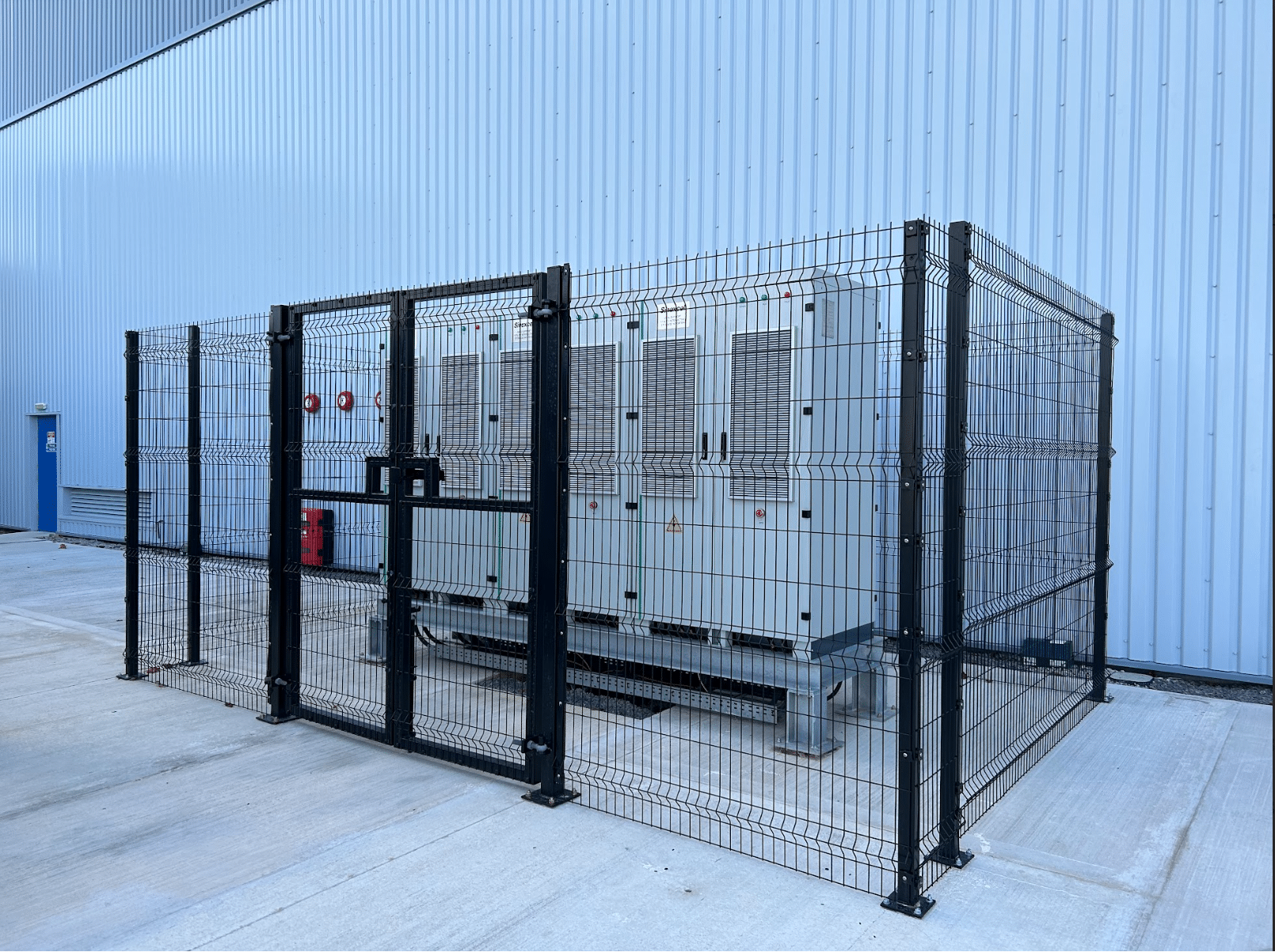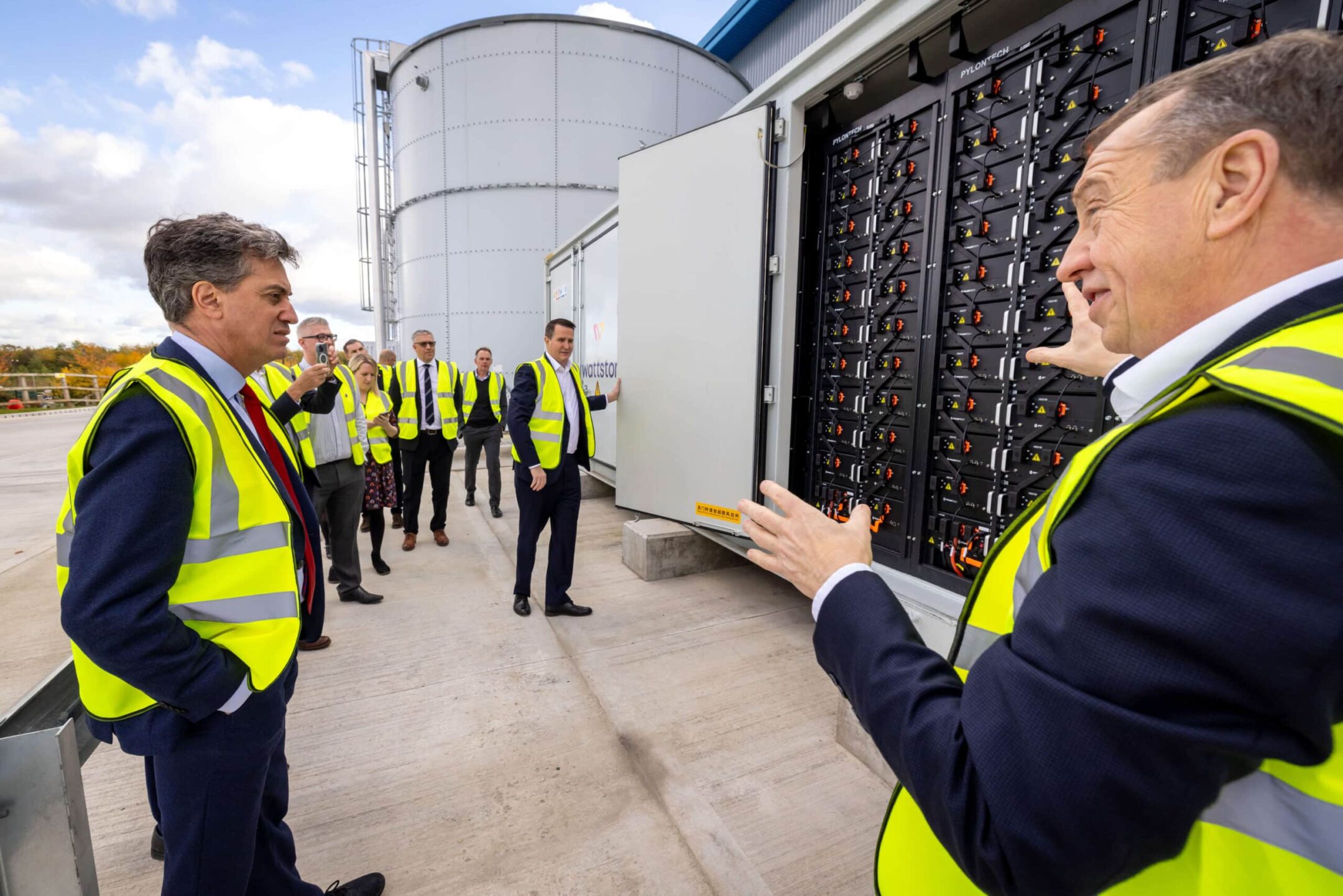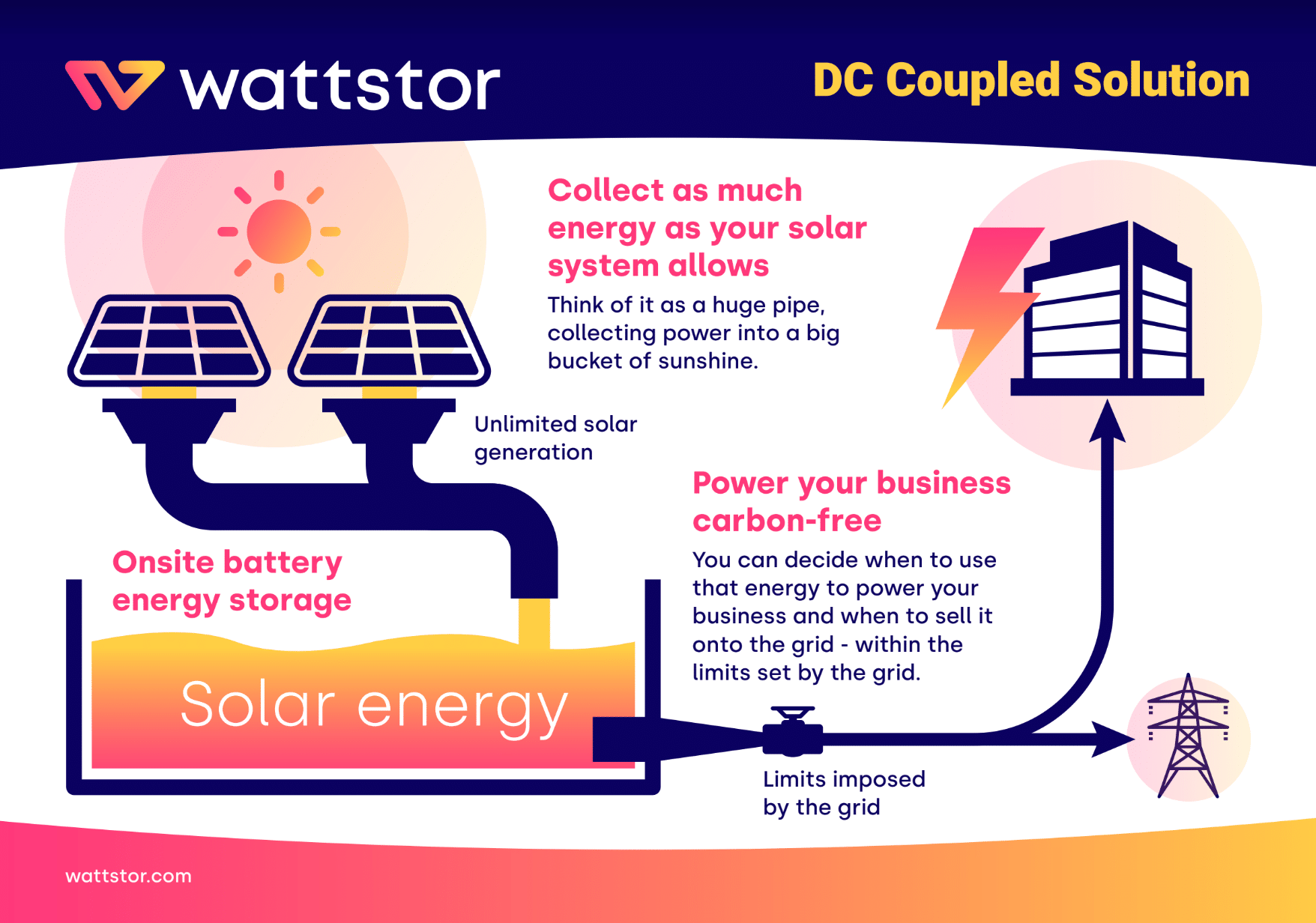[Ed Miliband listens to a DC-coupling explainer from Wattstor’s CCO, Kevin Ball, at a site visit in 2024.]
Everything you need to know about DC coupling with solar and battery storage
Solar PV has experienced a huge rise in popularity in recent years, with the UK reaching a record 13.3 TWh of solar generation in 2022.
But it’s not just large ground-mount and residential projects that contribute to the growth of solar PV. Industrial and commercial (I&C) organisations have also been quick to spot the potential of solar, and many have already invested in onsite solar projects to reduce their electricity bills, increase their energy resilience, and accelerate their transition to net zero.
What’s more, the benefits of onsite-generated solar power go well beyond companies’ bottom lines. A report by business energy provider, npower Business Solutions, showed that businesses could achieve 6.5 GW of installed rooftop solar by 2035, supporting the UK’s independence from imported gas and helping accelerate the clean energy transition.
The financial and environmental benefits of onsite solar projects – both for businesses and on a national scale – are clear to all. However, grid constraints have often limited the potential of these projects. The grid is in danger of reaching full capacity as more renewable sources are added. New solar installations are either denied permission to connect, or forced to downsize, making them unprofitable.
Luckily, direct current (DC) coupled solar and battery systems represent the ideal solution for I&C organisations to bypass these constraints.
How does DC coupling work?
Wattstor’s DC coupled solar and battery storage systems offer organisations the chance to really think outside the grid – building a solar project big enough to satisfy their energy needs, without having to worry about grid constraints. Here’s how it works.
Our expert engineers will consider the energy profile of an organisation and the characteristics of its premises. They will then create a bespoke project design that maximises available space to allow the client to install as much solar capacity as possible – in line with the client’s energy needs and net-zero ambitions.
Solar panels generate DC electricity, and sends it to a battery large enough to store it. Think of the battery as a bucket of sunshine: the larger the bucket, the more solar energy it can accommodate.
Because batteries also store energy as DC electricity, there is no need to convert it into AC electricity (alternating current, i.e.: what comes out of a power plug and is used to power machines, lights etc) at this stage.
We can then connect the battery to the electricity network on site (which is connected directly to the National Grid) to allow customers to use the energy onsite, sell any excess solar energy they generate, or to charge the battery with grid electricity when this is convenient. To do this, we’ll need to install an inverter to convert the electricity from DC to AC, as our grid system runs on AC electricity.
A critical component of the system

DC Coupled unit installed at a large distribution warehouse in the UK.
The inverter we install will only be as big as the grid allows (AC electricity supplied to users on site is what the grid uses to determine any potential constraints). While the rest of the energy in your “bucket” (stored as DC electricity) will not impact any grid limits and will be used to power your business operations, as and when needed.
This means that customers can use and/or sell their excess energy within grid constraints, while harnessing the full potential of their solar PV installation to run business operations on up to 100% renewable energy.
To put it simply, DC coupling allows us to install far more solar capacity than grid constraints would allow, exponentially increasing the potential of your onsite renewable energy system.
Wattstor’s DC Coupled Solution
AC vs DC: which is best for solar battery storage?
If you’ve already looked into building an onsite solar+battery project, or would like to add a battery to your existing solar installation, you’ve probably come across the difference between alternating (AC) and direct current (DC) coupled solutions.
AC coupled solar and battery systems have been the norm until recently – this is how they work.
Solar panels generate DC electricity. This is sent to a solar inverter that turns it into AC electricity, before being sent to the grid to be sold, and to your business premises to be used. Excess energy is converted again into DC electricity and stored in a battery.
There are three major problems with this approach:
- Because your solar energy will be sent straight to the grid, grid constraints will limit the size of your solar project.
- Because of the limited scale of your project, you won’t be able to unlock the full financial and environmental benefits of your solar generation potential.
- Electricity will be converted twice if you store it on site, meaning you’ll need two inverters instead of one, and you’ll lose up to 2% of your energy at every conversion.
Given these disadvantages, why has AC coupling been the traditional approach? When solar PV emerged, grid constraints were not a big issue. The idea of connecting a battery storage to the solar installation was also not yet widespread.
As a result, companies would just build their solar project and connect it straight to the National Grid and their onsite electricity network, converting solar energy from DC to AC before doing so. As more and more companies realised the benefits of having a battery storage system, they retrofitted the battery to their existing solar project. To do that, they needed to convert the electricity back into DC.
However, installing a DC coupled system from the get go has huge benefits for I&C organisations:
- It allows them to successfully overcome grid constraints and build a solar system which is as big as their rooftop or ground-mount space allows.
- Because the system is not limited in size (beyond the available space on site), it has the potential to generate all the clean energy a company needs, drastically reducing or even eliminating energy bills.
- More renewable energy means less Scope 2 emissions. – With a system unlimited by grid constraints, organisations have the potential to eliminate their Scope 2 emissions completely.
Curious to find out more?
Is DC coupling right for me?
Those who want to generate their own solar power onsite but face grid limitations will find DC coupled solar and battery projects an ideal solution, especially if they have rooftop or ground-mount space available.
They are also a great choice for those who are keen to take control of their energy costs and not be dependent on the fluctuations of the wholesale energy market. Finally, DC coupled solar and batteries are perfect for Earth-conscious organisations that wish to make the most of their renewable generation assets, running as much of their operations as possible on renewable energy.
Ideal candidates for DC coupled projects are organisations with ample rooftop space and moderate load requirements – such as manufacturing plants, warehouses, logistics businesses, retail parks, leisure centres, supermarkets and more.
However, all I&C organisations can benefit from a DC coupled system, and our expert engineers will be able to create a bespoke design and size the system appropriately to best respond to your business’s energy needs.
And if you don’t have the available CapEx for a large solar project, don’t worry! Through our fully funded renewable energy systems, you can reap all the benefits of a state-of-the-art DC coupled solution, with none of the CapEx and risks.
What results can I expect from DC coupling?
- Way more solar capacity than grid constraints would allow (up to eight times and more)
- Electricity bills reduced by up to 100%, with typical reduction being around 70%
- Scope 2 emissions reduced by up to 100%
Take a look at what this meant for some of our clients:
A large pharmaceutical distributor
The challenge
- A load demand of 1.5 GWh/year, requiring a 1,700 kW of solar rooftop array
- Grid limit: 750 kW, 40% of what needed
Wattstor’s solution
- A 2500 kWh DC coupled battery
Results
- 100% of the plant’s load demand is coming from onsite solar
- 25% surplus generation is available to power EV trucks in the future
An agri-food business
The challenge
- Two areas for a solar project, one allowing 650 kW, one 1,500 kW
- Grid limit: 900 kW
Wattstor’s solution
- A 1500 kWh DC coupled system, feeding 750 kW into the grid
Results
- 100% of the plant’s load demand is coming from onsite solar
- 2-10% surplus generation is available to sell back to the grid
- Emissions reduced by 140%
A warehouse and distribution centre
The challenge
- 2000 kW of rooftop area available
- Grid limit: 750 kW
Wattstor’s solution
- A 1700 kWh DC coupled system, feeding 750 kW into the grid
Results
- 100% of the plant’s load demand is coming from onsite solar
- 5% surplus generation is available to sell back to the grid
- Emissions are reduced by 105%
Solar and battery 3.0: making the most of your DC coupling
As we have seen, the benefits of Wattstor’s DC coupled solutions allow I&C organisations to make the most of their available solar generation capacity. But once the system is in place, how do we make sure it offers the highest possible value?
This is where Wattstor’s ground-breaking EMS, Podium, enters the scene.
Podium uses real-time data and machine learning to assess current and future energy market conditions, determining when using electricity from the grid is most convenient – or even free – and when high demand or low supply makes it expensive.
Based on this, it will decide when is the best time to use onsite-generated solar energy, charge the battery system with cheap grid electricity, or export energy onto the grid to maximise returns.
Think of Podium as your new onsite energy expert, helping you make the most of your renewable energy assets, 24/7 and fully automated.
Podium’s predictive capabilities are unique on the market, and allow you to gain a competitive edge that traditional solar+battery systems simply can’t match. What’s more, Podium acts in the background without any human intervention, giving you complete peace of mind and allowing you to focus on what you do best: running your business.
Think outside the grid: Book your free discovery meeting with one of our energy experts. Find out how you can overcome grid constraints, reduce your emissions, and take control of your energy costs through DC coupling.

